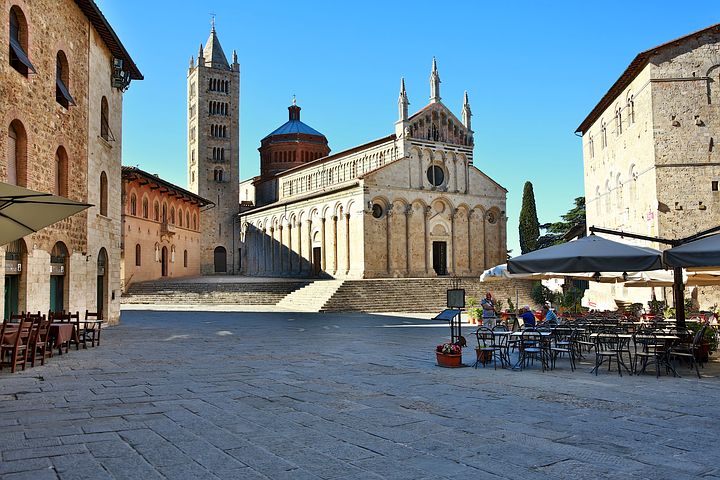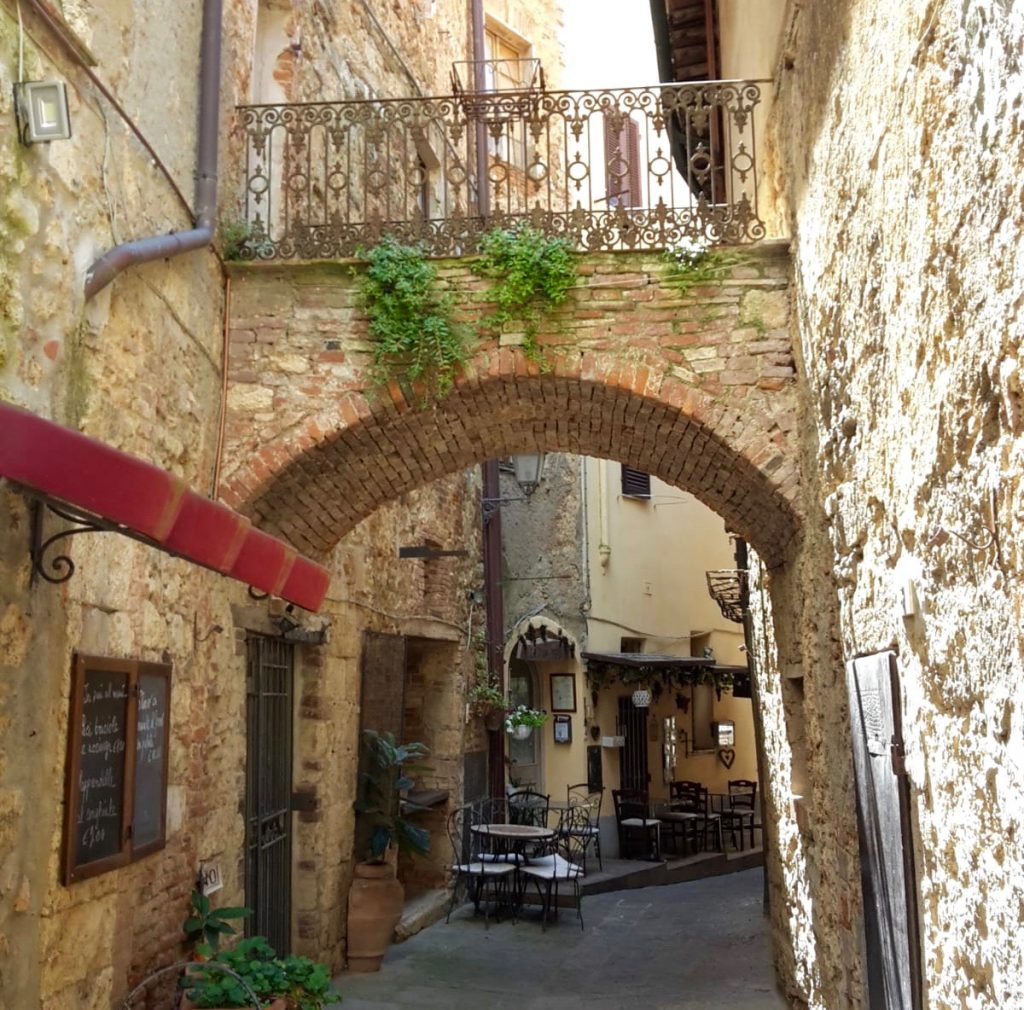A gorgeous Romanesque Cathedral dominates Massa Marittima, one of the most handsome towns in the Maremma, southern Tuscany. It boasts largely intact Medieval buildings and streets, that can be enjoyed away from the crowds.
Massa Marittima Tuscany highlights – the Cathedral
The main sight, in itself worth the trip to this part of Tuscany, is the magnificent Cathedral of San Cerbone, at the centre of Piazza Garibaldi, set atop a stepped podium. The bright interior matches perfectly the exuberance of the outside. While the lower part of the façade is clearly influenced by the Romanesque Pisan style, the upper shows a distinctly Sienese taste.
The central portal of the Cathedral has five panels with stories of Saint Cerbonius, patron of the town. He’s the one surrounded by geese. The story goes that while travelling to Rome he invited some geese to follow him as a gift to the Pope and they did. The rose window has rare 14th century glass depicting scenes from the life of the saint.
⇒ You’ll find plenty of surprises in the interior: an elegant Romanesque font (1267 with a top from 1447), a Gothic reliquary of Saint Cerbonius (1324) behind the main altar with scenes from his life, and a “Maestà” attributed to Duccio di Buoninsegna (1316).

Other sights in Massa Marittima, Tuscany
Next to the Cathedral the other major sight, is the Palazzo Pretorio (1220), a massive block of grey travertine with mullioned windows and a profusion of coats of arms on the facade. It hosts the small Archeological Museum with finds from local Etruscan tombs, and a gorgeous painting by Ambrogio Lorenzetti: “Madonna with Angles and Saints” (1335). Here the Sienese artist depicts the path to divine salvation through Love and Hope. This painting has an unusual feature: the Madonna and the child are pressed against each other in tender affection.
The other notable building in the square is the Palazzo Comunale, a mighty four-story building composed of Medieval house-towers.
The Sienese Fortress and its 13th century Chandelier Tower are a 10 minute steep walk but afford spectacular views.
The Complesso Museale di San Pietro all’Orto is a small but well curated museum of sacred art, with Medieval statues and paintings that once were in the town’s Cathedral, including the famous Lorenzetti’s Maestà (opening hours: November to March 11am-1pm and 3-5pm; from April until October 10am-1pm and 4-7p; closed on Monday).
⇒ A walk in Massa Marittima to discover all its highlights.

Don’t miss: a curious sight – Erotic Medieval Art
Palazzo delle Fonti dell’Abbondanza – This ancient font features a fresco (protected by a glass) of a tree covered with phalluses. It’s known today as “The Tree of Fertility”. It’s in Via Ximenes to the left of the Cathedral.
♥ 8 Picturesque Villages to visit in Tuscany.

A bit of history of Massa Marittima
Massa Marittima has lived for centuries on mining. The rich surrounding Colline Metallifere (metal-bearing hills) have been extracted since Etruscan time (copper, tin, lead, silver). In 1300 it was an important, wealthy centre in Southern Tuscany, called “Massa Metallorum”. It kept its independence until 1365 when it came under the control of Siena and later under the Florentine Medici family (when Siena was absorbed in the Duchy of Tuscany).
The population declined in the 16th century for the malaria, and the city was abandoned, that’s why many of the Medieval buildings remained intact until today. The Medici and later the Lorena family, that ruled over Tuscany from 1737, brought new life to this area with extensive reclamation works.
Nearby:
Only 20 km. from the sea, and some of the best beaches of Tuscany in the Gulf of Follonica.
Suvereto, 30 km. from Massa Marittima, is a Medieval small town well worth a visit.
⇒ Discover all the highlights of the Maremma region in southern Tuscany.

